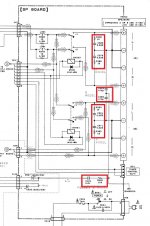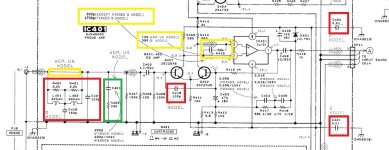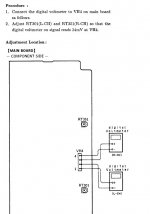Hey People,
New to this forum, so please bear with me....
I'm not a real electronics expert, not even by far, but I do grasp some of the basics.
I've had some Sony audio equipment from the eraly nintees, bought that when I was a lot younger... that stuff had been moved around, and had stayed unused the last couple of years. now, since I had the room again to set up this gear, I connected everything, and hurray, it still worked... well, kinda.... soon trouble began, skipping cd's, tuner that wouldn't stay tuned, amp cracling merrily.... so, I decided to open up this stuff, clean the lens on the CD player, clean the pots on the amp, and so on.... to cut a long story short: I managed to blow up the PS on the cd player, and decided to get me a "new" old one... I had Always been a fan of the ES series, but at the time, this was simply too expensive for me... butt now, wall, I managed to score a very decent Sony CDP-X55ES. Wow, does this thing sound good!!! so good, it bring out the limitations in my amp... so, out with the old amp, and in comes a vintage Sony TA-F690ES. again, better sound!! still some crackling now an then though.... well, traced that down to a dirty selector switch. unsoldered that one (is motorized), cleaned it up, and no more crackling noises....
Now, onto the title of this topic: this particular amp is a G-German model. when looking at the scematics, I see it has some extra components (filters??) compared to the AEP version (more connections to ground, capacitors between chassis and ground, filter on speaker output, filters and coils on phono-input) Could anyone tell me what those are for, and if they have an influence on sound? I suppose they are there because of different legislation in Germany?
Also, I read some on old Caps going bad.. since this is an '92 amp, would sound benefit from swapping out the caps? and if so, can I simply swap all caps with new ones with the same values?
pardon my ignorance.... ;-)
Wim
Belgium
New to this forum, so please bear with me....
I'm not a real electronics expert, not even by far, but I do grasp some of the basics.
I've had some Sony audio equipment from the eraly nintees, bought that when I was a lot younger... that stuff had been moved around, and had stayed unused the last couple of years. now, since I had the room again to set up this gear, I connected everything, and hurray, it still worked... well, kinda.... soon trouble began, skipping cd's, tuner that wouldn't stay tuned, amp cracling merrily.... so, I decided to open up this stuff, clean the lens on the CD player, clean the pots on the amp, and so on.... to cut a long story short: I managed to blow up the PS on the cd player, and decided to get me a "new" old one... I had Always been a fan of the ES series, but at the time, this was simply too expensive for me... butt now, wall, I managed to score a very decent Sony CDP-X55ES. Wow, does this thing sound good!!! so good, it bring out the limitations in my amp... so, out with the old amp, and in comes a vintage Sony TA-F690ES. again, better sound!! still some crackling now an then though.... well, traced that down to a dirty selector switch. unsoldered that one (is motorized), cleaned it up, and no more crackling noises....
Now, onto the title of this topic: this particular amp is a G-German model. when looking at the scematics, I see it has some extra components (filters??) compared to the AEP version (more connections to ground, capacitors between chassis and ground, filter on speaker output, filters and coils on phono-input) Could anyone tell me what those are for, and if they have an influence on sound? I suppose they are there because of different legislation in Germany?
Also, I read some on old Caps going bad.. since this is an '92 amp, would sound benefit from swapping out the caps? and if so, can I simply swap all caps with new ones with the same values?
pardon my ignorance.... ;-)
Wim
Belgium
Up to the early '90s, Germany had about the strictest EMI/RFI regulations of any country. These were then EC harmonized away, the result arguably being too lax instead.
Anyway, manufacturers' solutions to meet said requirements were not always very pretty and sometimes downright kludges that didn't exactly benefit sound. Phono input capacitance, for example, could become pretty high at times.
This unit would have been using good-quality parts, and assuming normal domestic use, is not old enough to warrant a shotgun replacement of all electrolytics. Something like that is always a good opportunity to introduce new problems that weren't there before, plus you don't seem to be aware of the variations in properties and quality among electrolytics yet. I would rather buy / make an ESR meter, or at least the makeshift version that inserts the capacitor under test between an audio amplifier (must have low DC offset or a pull-down resistor if AC-coupled) and a speaker - in a certain range you can tell by sound whether the cap is good or not.
Anyway, manufacturers' solutions to meet said requirements were not always very pretty and sometimes downright kludges that didn't exactly benefit sound. Phono input capacitance, for example, could become pretty high at times.
This unit would have been using good-quality parts, and assuming normal domestic use, is not old enough to warrant a shotgun replacement of all electrolytics. Something like that is always a good opportunity to introduce new problems that weren't there before, plus you don't seem to be aware of the variations in properties and quality among electrolytics yet. I would rather buy / make an ESR meter, or at least the makeshift version that inserts the capacitor under test between an audio amplifier (must have low DC offset or a pull-down resistor if AC-coupled) and a speaker - in a certain range you can tell by sound whether the cap is good or not.
Hey,
thx for the reply... indeed, I'm not familiar with the different properties of cap around today, and since i stick to 'don't fix what isn't broken', I'll leave it alone for now... What I do notice, is that my old amp (Sony TA-F300) seems to sound 'deeper' in the low end, and less 'sharp' in the high end.... maybe to do with the TA-F690ES using mosfet's? I do have the scematics of both......
Wim
thx for the reply... indeed, I'm not familiar with the different properties of cap around today, and since i stick to 'don't fix what isn't broken', I'll leave it alone for now... What I do notice, is that my old amp (Sony TA-F300) seems to sound 'deeper' in the low end, and less 'sharp' in the high end.... maybe to do with the TA-F690ES using mosfet's? I do have the scematics of both......
Wim
The TA-F300 is not exactly a damping factor king, and its protection relay may have seen better days (Sony's lesser amps from the early '90s are quite notorious for this). That could easily explain the difference, plus tone controls may also be slightly non-flat when centered. I would check the relay - try knocking it with a screwdriver grip in operation, if that's audible in the speakers it may appreciate some TLC (opening and cleaning contacts if not too far gone, NO SANDPAPER) or being replaced altogether.
What I actually meant, is that in my opinion, the 300 sounded somewhat better, i.e. "warmer" than the 690 does.... maybe the 690 needs to grow on me..... cleaning the input selector on it improved sound drastically, but phono still sound a bit dull.... I may end up removing the input filter there, and bring it to "AEP" specs (just like my old 300 is....)
But what I meant was that "better" may not actually objectively be better. And while said symptoms may also indicate e.g. low bias or other issues in the 690ES, high output impedance often has precisely the effect of giving a boomier sound because frequency response will start following loudspeaker impedance response and that tends to have a peak down there.
How much input capacitance do you have on the phono now, and what kind of cartridge?
How much input capacitance do you have on the phono now, and what kind of cartridge?
The record player is a vintage Technics SL220, cartridge is the Original EPC-270. No idea on the capacitance..... Original specs of the cartridge are 47 to 100 k
attached are the scematics of two of the sections that are different between AEP and G models.
One is the speaker output board. additional components are marked in red. I suppose removing these is straightforward and wil not impact the rest of the circuitry. Will it impact sound though?
the other is the phono pre-amp section. modification there would be a little more imvolved: sections in red are additional to the G version, so these would have to be removed, and replaced by the bridge (blue section) and section in green. yellow sections are differet components (values).
again, will this affect audio?
Wim
One is the speaker output board. additional components are marked in red. I suppose removing these is straightforward and wil not impact the rest of the circuitry. Will it impact sound though?
the other is the phono pre-amp section. modification there would be a little more imvolved: sections in red are additional to the G version, so these would have to be removed, and replaced by the bridge (blue section) and section in green. yellow sections are differet components (values).
again, will this affect audio?
Wim
Attachments
Most of the extra components are devoted to tying the chassis to ground at RF (or vice versa), these are generally harmless IMHO as at audio frequencies both sides are at the same potential anyway. I'm a bit surprised that only the G model would have a Zobel network at the output.... ah, that's a second one. Hmm, that's a 10R 1/2W + 22n 50 V film whereas the primary one is 15R||15R 1/2 W each + 2x 47 nF 50 V in series. A single 50 V rated cap in an amp with nominal +/-54.5 V rails? That's a bit concerning. I would look out for a similar 100 V rated part instead.
In the phono input, the LCLC input filter definitely is the right way to do it, input capacitance even ends up a bit lower than the standard model - though whether 200 pF always is low enough remains debatable (there are some cartridges like many ATs that recommend 100-200 pF, and the tonearm wiring + cabling tends to weight in at >100 pF alone). EPC-270 should be one of Technics' largely cap-load-invariant cartridges though, fairly nice cart. I would have to simulate the difference with a simulated cartridge source impedance. MM cartridge loading is a tricky subject that IMHO accounts for a lot of the differences between different competent phonopres.
Interesting, they're crossing over the phono input stage much earlier in the G model but final gain isn't as low. To make up for lost GBW at audio frequencies, they've bootstrapped the input instead, which happens to keep some RF away from the undegenerated input stage as well. Not entirely sure what to make of this.
There is an additional 100p input cap at the input (C102/152), but that's neither unduly high nor would something like that be expected to be unduly nonlinear. Interesting, it's a polyester cap in the F590ES (didn't know they even made these that small), and a polypropylene in the F690ES. A polypro is nothing to worry about.
And yes, you can do the adjustment like this. Make sure the amp is warmed up.
BTW, there are a fair few fusible resistors in this one. It couldn't hurt to make sure that none of them have gone unacceptably high.
Should you intend to use headphones on this one, a mod would be in order, as 470 ohms of output impedance really is unacceptably high.
For a "levelling the playing field" kind of exercise, you could try running the "pre-out" (which really is nothing but an attenuated speaker out) into the F300 and see how that sounds. Ideally you'd have a dummy load at hand to test with that as well (since an unloaded test also removes crossover distortion), otherwise maybe speakers in another room. I would also try out the Direct input.
In the phono input, the LCLC input filter definitely is the right way to do it, input capacitance even ends up a bit lower than the standard model - though whether 200 pF always is low enough remains debatable (there are some cartridges like many ATs that recommend 100-200 pF, and the tonearm wiring + cabling tends to weight in at >100 pF alone). EPC-270 should be one of Technics' largely cap-load-invariant cartridges though, fairly nice cart. I would have to simulate the difference with a simulated cartridge source impedance. MM cartridge loading is a tricky subject that IMHO accounts for a lot of the differences between different competent phonopres.
Interesting, they're crossing over the phono input stage much earlier in the G model but final gain isn't as low. To make up for lost GBW at audio frequencies, they've bootstrapped the input instead, which happens to keep some RF away from the undegenerated input stage as well. Not entirely sure what to make of this.
There is an additional 100p input cap at the input (C102/152), but that's neither unduly high nor would something like that be expected to be unduly nonlinear. Interesting, it's a polyester cap in the F590ES (didn't know they even made these that small), and a polypropylene in the F690ES. A polypro is nothing to worry about.
And yes, you can do the adjustment like this. Make sure the amp is warmed up.
BTW, there are a fair few fusible resistors in this one. It couldn't hurt to make sure that none of them have gone unacceptably high.
Should you intend to use headphones on this one, a mod would be in order, as 470 ohms of output impedance really is unacceptably high.
For a "levelling the playing field" kind of exercise, you could try running the "pre-out" (which really is nothing but an attenuated speaker out) into the F300 and see how that sounds. Ideally you'd have a dummy load at hand to test with that as well (since an unloaded test also removes crossover distortion), otherwise maybe speakers in another room. I would also try out the Direct input.
- Status
- Not open for further replies.
- Home
- Amplifiers
- Solid State
- Sony amps - "G" version


